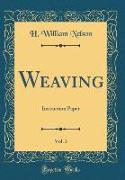- Start
- Weaving, Vol. 3
Weaving, Vol. 3
Angebote / Angebote:
Excerpt from Weaving, Vol. 3: Instruction PaperBy reducing the spreading out Of the spindle, the friction is taken Off for the bottom of the cop, which can be run almost with out friction, and by adding the piece Of ¿annel or felt, you add the friction for the commencement of the cep, the filling occupying a large Space as it draws off, and as the cop is reduced in size the filling clings around the spindle, this in a sense takes off the fric tion that was added by the insertion Of the ¿annel, so that taking both points into consideration considerable trouble will be saved, besides giving better cloth. Often the temple not being perfectly straight, that is, the face of the temple nearest the reed in the line with the fell of the cloth, causes the filling to be broken in the selvedge threads as the cloth passes through the temple. This is caused by the uneven pulling of the burr with the cloth. An extra large shed and uneven shedding will also cause this defect, and keeping the temple firm will cause the filling to be broken.It would be well to fix a piece of leather to the front of the lay, so that as the lay coines forward to beat up the filling the leather on the lay will come in contact with the lip of the temple, and force the temple back to about to i. This allows a little yielding of the cloth when the reed is in contact with it. The temple can be forced out too far, and the result desired will not be obtained. If the pin that holds the burr in the temple is rusty, holes in the selvedge will be the result. A badly worn burr will sometimes cause the filling to be broken in the selvedge by not having grip enough on the cloth, and when the reed is beating up the filling the yarn has to be spread out so much to be in line with the reed that the filling is broken, especially if there has been too much friction on the bottom of the cop. It is very seldom that this defect occurs in a full shuttle. Sometimes this defect is caused by a late picked shuttle, but only when nearing the bottom of the cop. This is caused by the extra strain on the selvedge as the shuttle forces its way through the selvedge threads it draws back the cloth at the same time from under the temple. If the filling catches in the box on the picker, or in any way is held instead of passing clear into the shed, as soon as it becomes loose, it is dragged into the shed, forming a thick place. By watching the loom for a short time, this is very soon remedied.About the PublisherForgotten Books publishes hundreds of thousands of rare and classic books. Find more at www.forgottenbooks.comThis book is a reproduction of an important historical work. Forgotten Books uses state-of-the-art technology to digitally reconstruct the work, preserving the original format whilst repairing imperfections present in the aged copy. In rare cases, an imperfection in the original, such as a blemish or missing page, may be replicated in our edition. We do, however, repair the vast majority of imperfections successfully, any imperfections that remain are intentionally left to preserve the state of such historical works.
Folgt in ca. 10 Arbeitstagen

